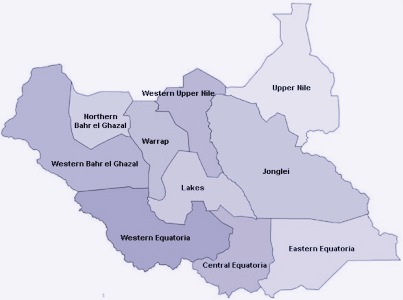SPLM-IO refutes similarities between proposed 21 and 28 states
November 22, 2015 (ADDIS ABABA) – The South Sudanese armed opposition faction of the Sudan People’s Liberation Movement (SPLM-IO) has described as “lacking informed analysis” media reports that both president Salva Kiir and his rival, Riek Machar, have similarly sought to create more states in the country which ensure dominance of their respective ethnic groups, the Dinka and the Nuer.

President Kiir’s government has also continued to shy away from calling the creation of more states a federal system, but the opposition leader Machar said this should be federalism.
While Machar proposed 21 federal states during the peace talks, president Kiir refused it but five weeks later ordered the creation of 28 states after a peace agreement based on the current 10 states was signed by the warring parties to end the 21-month long civil war in the world’s youngest nation.
Media publications which attempted to focus on analyzing negative similarities between actions of president Kiir and armed opposition leader, Machar, said the former has proposed 28 states which tend to give Dinka dominance over minority tribes in many of the states in greater Bahr el Ghazal and greater Upper Nile regions while the latter also proposed 21 states which gave ethnic Nuer dominance in states of greater Upper Nile region.
Dinka and Nuer ethnic groups are the first and second largest single communities, respectively, with historical rivalry and claimed dominance over the other 62 tribes in the country, with the allegations that the two leaders want to create states dominated by their ethnic groups.
The opposition faction of the SPLM-IO in response however said the analysis was not correct as there was no ill-intention on the criteria used for proposing the 21 states during the peace negotiations.
“Well, I cannot speak for the regime of President Kiir if their intention is to grab lands and dominate others. They will better explain how the proposed controversial 28 states came about and why they want to grab other people’s lands and give them to others,” opposition leader’s spokesman, James Gatdet Dak, told Sudan Tribune on Sunday.
“As for the 21 states proposed by the SPLM/SPLA (IO), these are based on the former colonial districts which have documented boundaries as stood from 1956. If a section of the Nuer community, or any other community, has by history happened to be the majority in a particular former colonial district, this is not the making of our leadership,” he argued.
Dak challenged that the analysis on the negative similarities should have considered the basis for creation of the states instead of “rushing to try to find fault” where there is no fault in the SPLM-IO.
He said it was important that the opposition faction should have been contacted by those interested in analyzing the criteria in the creation of the states for better explanation, as the conclusion seems to be “lacking informed analysis.”
The opposition leader’s spokesman further said the leadership of the SPLM-IO had not tempered with the historical setup and boundaries of the 21 former colonial districts, but simply proposed to transform them into 21 federal states.
He said, for instance, in Jonglei state, former Bor colonial district would become a state while Akobo district would become another state, saying in the proposed 21 states no land would be grabbed from one community and given to the other as happening in the 28 states proposed by president Kiir where part of greater Akobo land is given away to greater Bor in violation of their historical boundaries.
He added that Baliet county, for example, which is inhabited by an ethnic Dinka section in Upper Nile state, is part of the former colonial greater Nasir district, predominantly inhabited by the Jikany Nuer section, and that the new proposed Sobat state did not draw new boundaries apart from the 1956 borders.
The logic behind the decision to create 21 states based on the colonial boundaries, he said, was to avoid conflicts in determining new boundaries for the new federal states, as communities have lived with and respected these historical boundaries for several decades.
He said the SPLM-IO had no intention to create the states on ethnic lines and redraw boundaries contrary to the proposed 28 states by the government.
Dak also revealed that the proposed 21 federal states shall remain the policy of the SPLM-IO which they will present during the constitutional making process under the transitional government of national unity.
He however clarified that the SPLM-IO has respected the current 10 states as the basis for the peace agreement signed in August and for the formation of the transitional unity government, adding they will further submit the 21 states proposal in the permanent constitution-making process in accordance with the peace agreement.
The opposition leadership, he said, has called on the government in Juba to reverse its unilateral order on the 28 states and abide by the peace agreement, saying the decision and the manner in which the government wants to impose the new states is a violation and problematic.
(ST)
